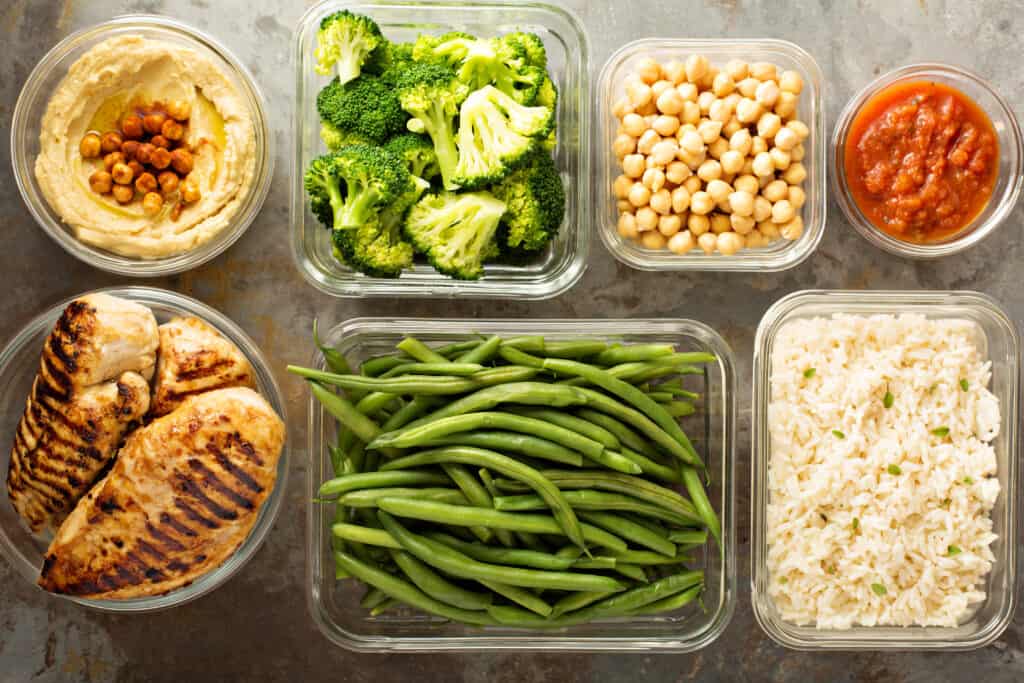
About one in eight women in the U.S. will develop breast cancer in her lifetime, making breast cancer one of the most common diseases affecting women in the U.S. While about 5-10 percent of breast cancer cases in the U.S. are related to an inherited gene mutation, most cases are linked to other factors — including lifestyle.
That’s why healthy lifestyle choices, like maintaining a healthy weight and eating a healthy diet, may lower your risk of breast cancer and other health conditions, such as heart disease.
What does a healthy lifestyle look like and how can you incorporate healthy habits?
Meal prepping is the perfect way to ensure you can plan and prepare healthy meals at home, even on hectic weeknights.
1. Start with Your Schedule
When determining which days you want to cook at home, consider your schedule during the week. Do you work late on certain evenings? Do members of your family have certain activities during the week that will make cooking at home difficult? Take note of which days you will be away from home in the evenings and consider planning to eat at a restaurant with healthy option on those days.
Remember to give yourself flexibility when planning. If you have a big event or activity on your calendar one day during the week, plan to eat takeout or make an easy-to-prepare meal at home that day. Once you have finalized your schedule for the week, identify which days you plan to cook at home.
2. Choose Your Recipes
When picking out recipes for your meal plan, start by looking at which ingredients you already have at home. Which ingredients can you use from your pantry, refrigerator and freezer to help reduce food waste and shorten your grocery list?
Think through your meal plan for breakfast, lunch, dinner and snacks. Don’t overcomplicate it. Utilize leftovers when possible. Note whether you need to pack lunches for work or school, or if you plan to rely on pre-packaged lunch options like salad kits.
When choosing recipes for dinner, be realistic and honest about your preferences. If you like cooking simple meals, stick with recipes with shorter ingredient lists and steps. Consider using healthy, pre-prepared meals when possible. If you enjoy cooking, consider choosing only one time-intensive recipe for the week so you aren’t overwhelmed.
You can find healthy, simple recipes on blogs, social media and in recipe books. Ask friends and family to share their favorite healthy recipes so you can swap ideas. Additionally, ask the members of your household to write down three to five meals they enjoy. This will help you build a list of go-to meals to make on a rotating basis. Building a list of 10-30 meals you enjoy will make it quick and easy to choose recipes for the week.
Additionally, consider ways to make healthier substitutions in your recipes and snack choices:
- Substitute carrots for chips.
- Make sweet potato fries in the oven instead of using frozen French fries.
- Choose whole grain bread and pasta.
- Substitute spaghetti squash and other vegetable noodles like zucchini in place of pasta.
- Snack on nuts instead of candy.
- Substitute avocado oil for butter.
- Use ancient grains like farro or quinoa instead of white rice.
- Use whole beans like pinto beans instead of refried beans.
- Use lower-calorie condiments such as mustard instead of mayo.
- Use balsamic vinegar and oil instead of cream-based salad dressing.
- Serve sauteed vegetables instead of mashed potatoes, or a side salad instead of a fried side dish.
3. Make Your Grocery List
Once you have your meal plan for the week, make a grocery list. Consider the grocery shopping strategy that works best for you and your family. Do you prefer to buy groceries every day or only once a week? Do you prefer planning out a meal plan for the whole month and going to the grocery store for one bulk shopping trip?
When writing your list, think of ways to be resourceful. Can you make a double portion of a recipe and freeze half to use on a busy weeknight later in the month?
4. Go Grocery Shopping
To save time when grocery shopping, consider taking advantage of curbside pickup or grocery delivery. If you want to utilize these services but aren’t sure where to start, ask a friend or family member for help on how to order your groceries. While some delivery services charge a fee, some grocery stores offer free curbside pickup.
5. Start Prepping
Once you have your ingredients, decide how much meal prepping your schedule allows and determine when you want to meal prep. Do you prefer to block off an afternoon on the weekend to wash and chop your produce and cook certain ingredients in advance to use in recipes throughout the week? For example, you can grill a large batch of chicken breasts to use during the week, and freeze some for later use.
If you prefer to block off a large amount of time to meal prep on a certain day, plan on eating some of the food you prep for dinner that day, or plan to eat takeout or a pre-prepared meal to make dinner more manageable. Another option is to meal prep while you are already in the kitchen making dinner; when you cut an onion, chop two onions and package the second to store in the refrigerator or freezer for later use.
Meal planning takes some time, but with intention it can be feasible. Break up your tasks into smaller pieces to make meal planning achievable. For weekly or monthly meal planning, consider planning recipes one day, grocery shopping the next day and meal prepping another day. Find a system that works for you and your family to incorporate healthy meals into your life.


